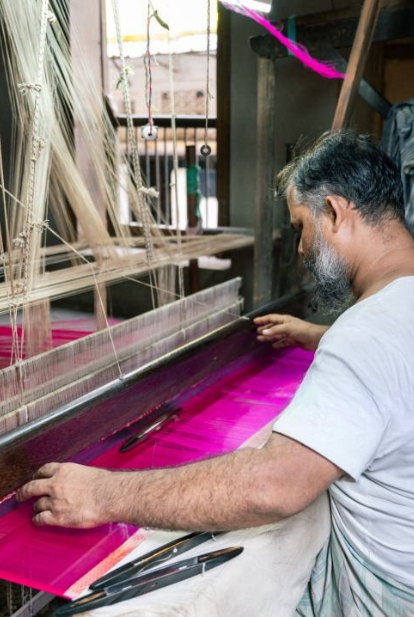The Ancient Art of Handloom: A Living Heritage
The story of handloom weaving begins over 5,000 years ago, when early civilizations first transformed fibers into fabric using simple wooden frames. In India, this craft reached extraordinary heights:
300 BCE: Mauryan era records mention specialized weaving villages 
Middle Ages: Indian handloom textiles became global luxury (exported to Rome, China)
Colonial Era: British mills nearly destroyed the industry by the 19th century
Today, authentic handloom survives through artisans and ethical brands like Weavehand. But how does it differ from modern powerloom? Let's unravel the truth.
The Key Differences at a Glance
Feature:
Making Process
Time Taken
Fabric Character
Environmental Impact
Artisan Connection
Handloom:
Hand-operated loom (human skill)
2-5 days per saree
Slight irregularities (proof of human touch)
Zero electricity, biodegradable
Directly supports weaver families
Powerloom:
Electric machine (automated)
2-5 hours per saree
Perfectly uniform
High energy use, chemical finishes
Factory mass-production
Why Handloom Matters More Than Ever
1. Each Piece Tells a Story

Handloom fabrics carry the weaver's personal touch
You can often see where the artisan changed shuttles
Weavehand includes artisan profiles with each purchase
2. Better for the Planet
- No electricity used in weaving
- Natural materials (cotton, silk, linen)
- Biodegradable after years of use
Did You Know? One powerloom consumes enough electricity in a month to run 15 handlooms for a year!
3. Comfort That Improves With Age
- Handloom fabrics breathe better (ideal for Indian summers)

They soften gradually like fine wine
The looser weave allows air circulation
Weavehand Tip: Our mul cotton sarees feel lighter than most machine-made fabrics.
How to Spot Authentic Handloom
Look For:

Imperfections - Minor unevenness in texture
Fringe edges - Hand-tied, not machine-cut
Floating threads - Where patterns change
Avoid:
Perfectly identical repeats

Plastic-like stiffness
Chemical smell
Pro Tip: Rub the fabric - handloom has a slightly irregular surface you can feel.
Common Myths Debunked
Handloom is always expensive

Weavehand's direct-to-consumer model keeps prices fair
Lasts 5x longer than powerloom = better value
Powerloom is more durable
Handloom's tighter hand-adjusted weave actually lasts decades
Many Weavehand customers still wear pieces from 10+ years ago
You can't get modern styles in handloom
Weavehand now offers contemporary silhouettes like tailored shirts and wrap dresses
The Weavehand Difference
When you choose our handloom: 
- You preserve dying crafts like Ikkat and Jamdani
- You support women weavers directly (no middlemen)
- You get heirloom quality that ages beautifully
Final Thought:
Your fabric choice isn't just about clothing—it's a vote for the world you want. While powerloom has its place  for mass needs, handloom represents living heritage, sustainability, and human connection.
for mass needs, handloom represents living heritage, sustainability, and human connection.
Ready to experience real handloom? Explore Weavehand's collection today—where every thread carries a story.




